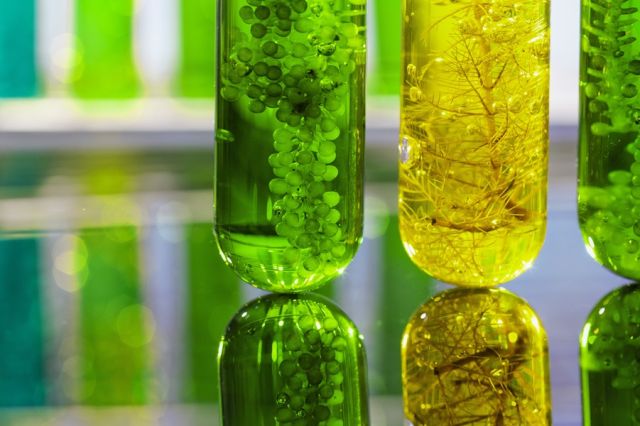
Executives from Occidental Petroleum-backed Cemvita, Carbon Optimum, Novozyme share insights into how CO2 could be used for biofuels, fertilizer, food, proteins, plastics and even oil. (Source: Shutterstock.com)
Biotechnology companies are turning CO2 into fertilizer, fuel, food proteins and other applications to help fight climate change and crack open potential new revenue streams.
With photosynthesis as inspiration, Florida-based Carbon Optimum uses CO2, waste heat and wastewater to produce algae. Denmark-headquartered Novozymes, part of Novonesis, converts CO2 into acetate, or vinegar, which is then put in fermentation tanks to produce proteins. Cemvita, the Houston-based company with Occidental Petroleum among its investors, engineers microorganisms that use waste streams and CO2 as feedstock.
The end results: biofuels, fertilizer, food for livestock and humans, oil, proteins and plastics.
“Most of what we’re all trying to do is copy nature … We’re trying to see this scale everywhere,” said Yao Huang, investor and board member for Carbon Optimum. “And it has impact on multiple industries, from food to energy to farming. I think at least for the next 50 years, this is going to be quite meaningful.”
Executives from the three companies spoke during a recent energy conference in Houston about biotechnology’s role in carbon capture. The discussion took place as companies across the world aim for net-zero emissions targets, seeking sustainable alternatives to fossil-based products and new uses for the greenhouse gas that contributes to climate change.
About 230 million tonnes (MMtonne) of CO2 is used annually, mainly in the fertilizer industry and for enhanced oil recovery, according to the International Energy Agency (IEA). However, new utilization pathways are gaining momentum with CO2-based synthetic fuels, chemicals and building aggregates.
“The current project pipeline shows that just under 15 [MMtonne] of CO2 per year could be captured for these new uses by 2030, including around 8 [MMtonne] CO2 in synthetic fuel production,” according to the IEA. “If all announced projects are commissioned, they could reach around two-thirds of the level of CO2 utilization for synthetic fuel production by 2030 envisaged in the Net Zero Emissions by 2050 (NZE) Scenario.”
However, that would require all CO2 be pulled from the air or from biogenic sources, such as that from biomass and its derivatives.
Biotechnology at work
Carbon Optimum’s proprietary technology harnesses photosynthesis at a high volume using captured CO2, Huang said. Nitrogen oxides and sulfur oxides are scrubbed out of the CO2, which is then piped into algae-filled tanks called photobioreactors. Here, algae consume the CO2, carrying out photosynthesis, and grows.
Instead of sunlight, the company uses LED lights along with water and a small amount of nutrients to produce the algae. The biomass, harvested in about 24 hours, can be used as an ingredient in a variety of products such as biofuel, crude oil, human food, cosmetics and pharmaceuticals—to name a few, according to the company’s website.
“We’re working with a large U.S. energy company with 9 million tons per year. Cement factories with 2 million tons per year. We’re working with a country to eliminate 30 million tons per year,” Huang said. “We’ve got another coal energy conglomerate for another 230 million tons per year.”
Carbon Optimum can flex to different scales because its algae tanks are modular.
“The beauty of this entire process is that the biomass taken out could be utilized into fertilizer, biofuels, food products, and it makes the whole thing extremely profitable,” Huang said.
Cemvita, which also mimics photosynthesis using CO2 as feedstock, essentially replicates what a soybean does in a lab, according to CEO Moji Karimi.
“Instead of having to have land and growing soybeans to crush it to get the oil out, you could actually engineer bacteria to give you the same exact profile of oil,” he said.

The company uses synthetic biology to transform CO2 into chemicals and alternative fuels such as sustainable aviation fuel (SAF). It has a partnership in place for SAF offtake with United Airlines, and Occidental—which is building one of the world’s largest direct air capture facilities in Texas—is a longtime technology partner and top investor.
Enzymes form the core of Novonesis’ technology.
“The enzymatic carbon capture process uses the biological enzyme carbonic anhydrase instead of conventional chemicals to extract CO2 from the flue gas,” Novonesis said on its website. The process is considered less expensive than conventional methods because it can use waste heat and it doesn’t require special wastewater treatment.
Klaus Lassen, head of carbon capture for Novonesis, said the company is also using enzymes for enhanced rock weathering. The process involves removing carbon from the air and storing it in rocks.
Eyeing economics
Carbon Optimum tech is scalable and can be quite profitable, Huang said. But financing is still required to make it happen, she added.
Carbon credits compose an extremely small percentage of the revenue for such projects. Most of the revenue based on the value of the commodities be it fertilizer, biofuels, food products or something else, according to Huang.
“That profitability has driven a lot of partners that you normally wouldn’t expect in this field to come on board for financial reasons,” she said. “Europe’s laws have driven a lot of demand, diverting taxes and fines from CO2 emissions from the major emitters there.”
Novonesis’ Lassen pointed out the value of having a lower CO2 footprint in production.
“You need to calculate these lower CO2 footprints and issue CO2 certificates on the voluntary market,” Lassen said. “That is where you really can tell that that you are doing something good for the sustainable future. And that is something that companies are ready to pay for.”
Karimi sees a future in which there are no shortcuts to lowering emissions, more collaboration between companies and infrastructure designed to emit less waste and CO2. A closed loop system could give CO2 utilization a huge advantage, he said.
“With sequestration, of course you have the carbon markets, but there’s really no inherent business model in that there’s a product made and there’s someone that is using the end product,” Karimi said. “Whereas once the CO2 utilization is scaled and competing with the other kind of low carbon alternatives, naturally people are just going to do more of that. So, we just let capitalism do what it does best to scale up that industry without the reliance on government grants in perpetuity.”
Like other new technologies, the panelists agreed that subsidies are needed in the beginning.
“You cannot expect new processes to have a competitive edge within the ten years. It’s simply not possible,” Lassen said.
Taking responsibility
Asked whether dependence on CO2 to make products could slow emission reductions initiatives, Huang said no.
“Most countries are shutting down their coal facilities. India is creating more. Cement factories will be there unless someone thinks of something else to build their skyscrapers with or something else,” she added. “But in the short term, the next 50 years, we have whatever we have, and regardless of whatever we get rid of, there’s still going to be CO2.”
Fertilizer shortages in parts of the world show the products are still needed, Huang said.
The panel discussion also swung to responsibility.
Lassen spoke about personal responsibility, saying individuals should lower their CO2 footprint.
“It is not an industry that is destroying the climate. The industry is producing petroleum products for you that you consume. It is your CO2 footprint,” he said, later suggesting people pay for their own waste disposal.
Huang disagreed, saying “a company that produces it forces you to use that. … Maybe as a European or as a wealthy individual, you have choices, but the masses do not. They have to use the bus that is burning oil to get to work.”
If the companies that produce plastic makes a change, though it may cost more, then “you don’t have to wait for 8 billion people to all decide the same thing,” she said.
Facilities don’t have to burn oil, Huang said; they could burn hydrogen.
“And if you make the whole thing profitable economically, it’ll work,” she said. “It’s business in the end.”
Recommended Reading
Comments
Add new comment
This conversation is moderated according to Hart Energy community rules. Please read the rules before joining the discussion. If you’re experiencing any technical problems, please contact our customer care team.

